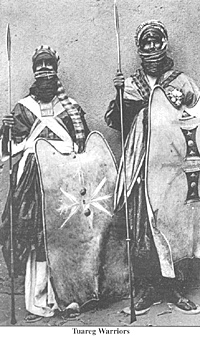 There is a wealth of wargaming to be had in this period and many figures are available. The best figure ranges for the battles with the French in the West or the earlier battles in the Eastern Sudan are probably to be found in the 25mm colonial ranges. The huge African battles in the middle years may be more suitable for smaller scales with such rules as DBR, DBA or HFG.
There is a wealth of wargaming to be had in this period and many figures are available. The best figure ranges for the battles with the French in the West or the earlier battles in the Eastern Sudan are probably to be found in the 25mm colonial ranges. The huge African battles in the middle years may be more suitable for smaller scales with such rules as DBR, DBA or HFG.
Taureg Warriors
The three main Shari River battles (Nyellim Hills, Kuno and Lakhta) are very suitable for The Sword and the Flame and can be easily adapted to other rules such as Battles of Empire.
Figures
The following are suggested models, most of which I have used and some of which appear on the front cover of Part 1 (issue 87).
French Marines, officers and NCO’s: Dixon Dahomey French, French Marines from the Old Glory Boxer Rebellion range.
Algerian Tirailleurs: Foundry and Castaway Arts Franco Prussian War range. Senegalese and Congolese Tirailleurs: Reviresco.
Laptots (French native riverine soldiers): Reviresco. French Boat Crews: Reviresco. Léon Blot: Dixon. Spahis
Algerians: Honorable Lead Boiler Suit Company.
Spahis Soudanais: Reviresco.
Five barreled Hotchkiss Cannon: Houston model from The London War Room (in the U.S.). 80mm Mountain Gun. These can be made from the old glory mountain gun in their Spanish American War range. These come as muzzle loaders, but can be easily converted by simply snipping off the cascabel and replacing with a squared off piece of plastic or modeling putty. (See photo on cover of issue 87).
Banner Warriors: Castaway Arts Sudanese figures, also available from Old Glory as Mahdist Arabs. Mix in with Old Glory Arab/Berber cavalry from their French Foreign Legion range. Also, mix in Zanzibari Arabs from the Foundry Darkest Africa Range.
Auxiliaries: Foundry Darkest African figures with Sudanic arched top shields.
Scenarios: The Shari River Battles
Using the Sword and the Flame: Count all tirailleurs as “British Rifles” for shooting and morale with shooting factors of (1-7, 1-6, 1-5, 1-4). Allow them to fire twice on a turn. Also allow them to fire half figures (rounded down) out to double range. This simulates the more deadly effects of magazine-fed, smokeless rifles. Consider Rabih’s Banner troops as Dervish Rifles, with shooting factors of (1-5, 1-4, 1-3, 1-2). Allow the repeaters to fire twice. These may also fire half figures out to double range. Consider auxiliaries as Dervish Spear. Rifled musket armed troops fire as Dervish Rifles - above - but only half figures (rounded down) may fire each turn (allowing 1/4 to fire out to double normal range). Count all artillery pieces the same, but allow half dice to double long-range. Captured artillery fire at half dice. You will notice that a different figure scale is used for each battle. This has no effect on the game mechanics - when used with Sword and the Flame. The actual numbers of troops involved is given in detail in the articles above and can be drawn upon for those applying these scenarios to other rules.
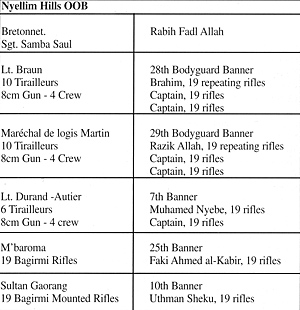 Nyellim Hills
Nyellim Hills
The French victory condition is to inflict a costly result on Rabih’s army. They do this by killing Rabih, or three or more of the banner leaders. If Rabih’s army avoids this, and capture all three mountain guns - this results in a major defeat for the French.
The units start as shown on the map with the exception of Rabih’s flanking banners. They may be placed on the board edge - as their full move, from turn 2 onwards. This is determined by rolling a D6 when their card is drawn. A 3-6 and they will enter - otherwise try again next turn.
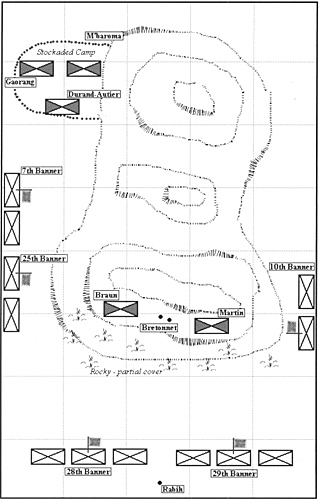
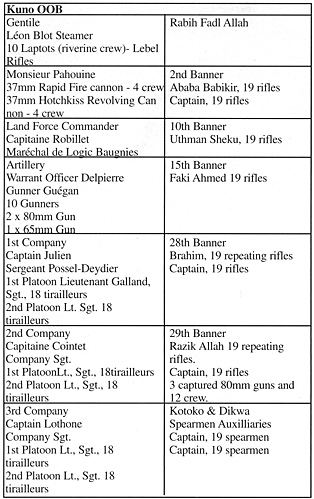 The Battle of Kuno
The Battle of Kuno
The French victory condition is to rout Rabih’s army. They must do this before their ammunition his depleted and TSATF’s ammunition rules should be used.
All units start on the board as shown. The steamer canot land at Kuno as the sand bar prevents this. The palisade is a formidable obstacle and an attempt can be made to force a breach with the artillery. Any “1” rolled while the artillery fire is directed at the palisade, may result in a breach. Roll a D6 for each 1 rolled in that volley - if a 6 is rolled - then the pallisade is breached wide enough for 3 men to pass.
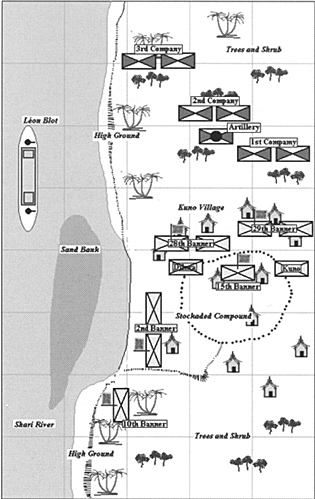
Bibliography
Gentil, Emile: La Chute de L’Empire de Rabah: 1901
Arab Djama Babikir: L’Empire de Rabeh:1950
R Buchta: The True Story of the Rebellion in the Sudan: 1884
Hallam, W.K.R.: The Life and Times of Rabih Fadl Allah: 1977
Reibell, General: Carnet de Route de la Mission Saharienne Foreau-Lamy 1898 - 1900: 1930
Gessi, F.: Seven Years in the Sudan: 1891
Barth, Henry: Travels and Discoveries in North and Central Africa 1849-1855 5 vols: 1858
Porch, Douglas: Conquest of the Sahara: 1984
Deux Campaignes au Soudan Francais
Balesi, Charles John: From Aversaries to Comrades-in-Arms: West Africans and the French Military 1885-1918: 1979
Cordell, Dennis D.: Dar al-Huti and the Last Years of the Trans-Saharan Slave Trade
McEvedy, Colin: The Penguin Atlas of African History: 1980
Spring, Chistopher: African Arms and Armour: 1993
Clayton, Anthony: France, Soldiers and Africa: 1988
Saint-Michele, Serge & Le Honzec, Rene: Les Batisseurs d’empire Histoire des Troupes de Marine Tome II 1871-1931
Anciens Établissements Hotchkiss: Catalogue de Matérile de Guerre: 1889
London Illustrated News - various issued from 1880 - 1900
African Warlord: Central Sudan, 1884 – 1911 Part 3
-
Part Three: The Fall of Empire
Part Three: The Many People of Rabih's World
Part Three: Wargaming the Period
African Warlord: Central Sudan, 1884 – 1911 Part 2
-
Part Two: Rise to Dominance
Part Two: Rabih's Army
Part Two: Organization of the Banners (very slow: 212K)
Part Two: Gentil's Missions 1897-1899
Part Two: Jumbo Color Illustration: Rabih's Warriors (slow: 319K)
African Warlord: Central Sudan, 1884 – 1911 Part 1
-
Part One: Battle of Nyellim Hills
Part One: A Leader Emerges
Part One: The Years Under Sulaiman
Part One: Azande Warfare
Part One: Jumbo Map of Central Sudan (slow: 116K)
Back to Table of Contents -- Courier # 89
To Courier List of Issues
To MagWeb Master Magazine List
© Copyright 2003 by The Courier Publishing Company.
This article appears in MagWeb.com (Magazine Web) on the Internet World Wide Web.
Other articles from military history and related magazines are available at http://www.magweb.com